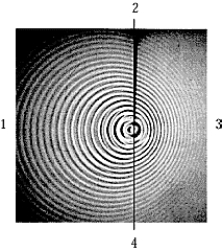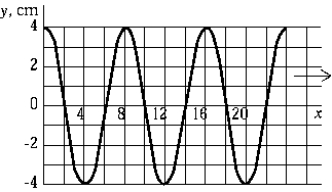A) double the angular frequency of the source.
B) double the amplitude of the wave.
C) double the tension in the string.
D) quadruple the tension in the string.
E) halve the linear density of the string.
G) D) and E)
Correct Answer

verified
Correct Answer
verified
Multiple Choice
Both particles and waves transfer energy from one location to another. Which of the following statements is true?
A) Both methods of energy transfer follow the conservation of energy principle.
B) Energy transfer by particles follows the conservation of energy principle but waves do not.
C) Energy transfer by waves follows the conservation of energy principle but particles do not.
D) Whether the transfer of energy by a wave follows the conservation of energy principle depends on the speed of the wave.
E) Whether the transfer of energy by a particle follows the conservation of energy principle depends on the speed of the particle.
G) B) and D)
Correct Answer

verified
Correct Answer
verified
Multiple Choice
 A pulse moves in a string toward a free end a ring on a post) as indicated in the sketch. On reflection, the pulse would most nearly be represented by
A pulse moves in a string toward a free end a ring on a post) as indicated in the sketch. On reflection, the pulse would most nearly be represented by
A) 1.
B) 2.
C) 3.
D) 4.
E) 5.
G) B) and E)
Correct Answer

verified
Correct Answer
verified
Multiple Choice
The fundamental frequency of a vibrating string is f1. If the tension in the string is increased by 50% while the linear density is held constant, the fundamental frequency becomes
A) f1.
B) 1.2f1.
C) 1.5f1.
D) 1.7f1.
E) 2f1.
G) A) and C)
Correct Answer

verified
Correct Answer
verified
Multiple Choice
 The figure represents a wire of length L, fixed at both ends, vibrating in several harmonics. The 7th harmonic is shown in
The figure represents a wire of length L, fixed at both ends, vibrating in several harmonics. The 7th harmonic is shown in
A) 1) .
B) 2) .
C) 3) .
D) 4) .
E) 5) .
G) A) and E)
Correct Answer

verified
Correct Answer
verified
Multiple Choice
A musical pitch is played at 60 dB. Another is played that sounds 4 times as loud. The sound intensity level of the second pitch is
A) 80 dB.
B) 100 dB.
C) 66 dB.
D) 64 dB.
E) 240 dB.
G) A) and E)
Correct Answer

verified
Correct Answer
verified
Multiple Choice
Which of the following wavefronts results from a supersonic flight? 
A) 1)
B) 2)
C) 3)
D) 1) and 3)
E) They are all supersonic.
G) B) and D)
Correct Answer

verified
Correct Answer
verified
Multiple Choice
Two wave trains of the same frequency are traveling in opposite directions down a string. When they meet, these wave trains will not
A) be described by the principle of superposition.
B) bounce off each other and switch directions.
C) pass through one another.
D) continue to carry energy.
E) remain transverse.
G) B) and E)
Correct Answer

verified
Correct Answer
verified
Multiple Choice
A string 2.0 m long has a mass of 2.4 10-2 kg. When fixed at both ends, it vibrates with a fundamental frequency of 150 Hz. The speed of a transverse wave in the string is
A) 3.6 m/s.
B) 75 m/s.
C) 0.30 km/s.
D) 0.60 km/s.
E) 0.63 km/s.
G) A) and E)
Correct Answer

verified
Correct Answer
verified
Multiple Choice
When an organ pipe, which is closed at one end only, vibrates with a frequency that is 3 times its fundamental first harmonic) frequency,
A) the sound produced travels at 3 times its former speed.
B) the sound produced is its fifth harmonic.
C) beats are produced.
D) the sound produced has one-third its former wavelength.
E) the closed end is a displacement antinode.
G) A) and B)
Correct Answer

verified
Correct Answer
verified
Multiple Choice
If you were to double the speed of a wave on a string while keeping the frequency and amplitude of the wave constant, the rate at which energy is delivered by the wave would
A) double.
B) quadruple.
C) be reduced 50%.
D) be reduced to 25% of its previous value.
E) be unchanged.
G) C) and D)
Correct Answer

verified
Correct Answer
verified
Multiple Choice
The fundamental frequency of a vibrating string is f1. If the tension in the string is quadrupled while the linear density is held constant, the fundamental frequency becomes
A) f1.
B) 1.2f1.
C) 1.5f1.
D) 1.7f1.
E) 2f1.
G) B) and D)
Correct Answer

verified
Correct Answer
verified
Multiple Choice
A sinusoidal wave train is moving along a string. The equation giving the displacement y of a point at coordinate x has the form where the units are SI. The wavelength is
A) 8.0 cm.
B) 15 cm.
C) 6.0 m.
D) 12 m.
E) 60 m.
G) B) and C)
Correct Answer

verified
Correct Answer
verified
Multiple Choice
The frequency of a car horn is f. What frequency is observed if both the car and the observer are at rest, but a wind is blowing toward the observer?
A) f
B) greater than f
C) less than f
D) either greater or less than f
E) far greater than f, depending on how wind speed compares with the speed of sound
G) B) and E)
Correct Answer

verified
Correct Answer
verified
Multiple Choice
 The object shown in the figure is
The object shown in the figure is
A) traveling from 2 toward 4.
B) traveling from 3 toward 1.
C) traveling from 1 toward 3.
D) traveling from 4 toward 2.
E) not in motion.
G) A) and C)
Correct Answer

verified
Correct Answer
verified
Multiple Choice
For a tube of length 57.0 cm that is open at both ends, what is the frequency of the fundamental mode? The speed of sound in air is 340 m/s.)
A) 149 Hz
B) 447 Hz
C) 596 Hz
D) 298 Hz
E) 746 Hz
G) A) and E)
Correct Answer

verified
Correct Answer
verified
Multiple Choice
 The graph shows a wave moving from left to right. If the period of this wave motion is 50 m/s, the wave is moving with a velocity of
The graph shows a wave moving from left to right. If the period of this wave motion is 50 m/s, the wave is moving with a velocity of
A) 40 π cm/s.
B) 1.6 π m/s.
C) 1.6 m/s.
D) 80 cm/s.
E) 0.40 cm/s.
G) B) and E)
Correct Answer

verified
Correct Answer
verified
Multiple Choice
During the passage of a longitudinal wave, a particle of the medium
A) remains in a fixed position.
B) moves in a circle.
C) moves at right angles to the direction of propagation.
D) moves forward and backward along the line of propagation.
E) moves forward with the velocity of the wave.
G) None of the above
Correct Answer

verified
Correct Answer
verified
Multiple Choice
Car A moves at speed v toward car B, which is at rest. The frequency of car A's horn is observed by car B to be f. What is the frequency of car A's horn as heard by an observer in car B if car A is at rest and car B moves at speed v toward car A assume there is no wind) ?
A) f
B) greater than f
C) less than f
D) either greater than or less than f
E) 2f
G) A) and C)
Correct Answer

verified
Correct Answer
verified
Multiple Choice
A police car siren emits a sound at 600 Hz. If an observer moves toward the source at 50 km/hr and hears a siren frequency of 678 Hz, calculate the speed of the police car and whether it is approaching or receding from the observer assume the speed of sound in air is 343 m/s) .
A) 99.0 km/hr receding
B) 144 km/hr approaching
C) 99.0 km/hr approaching
D) 144 km/hr receding
E) Not possible for any reasonable police car speed.
G) D) and E)
Correct Answer

verified
Correct Answer
verified
Showing 21 - 40 of 198
Related Exams